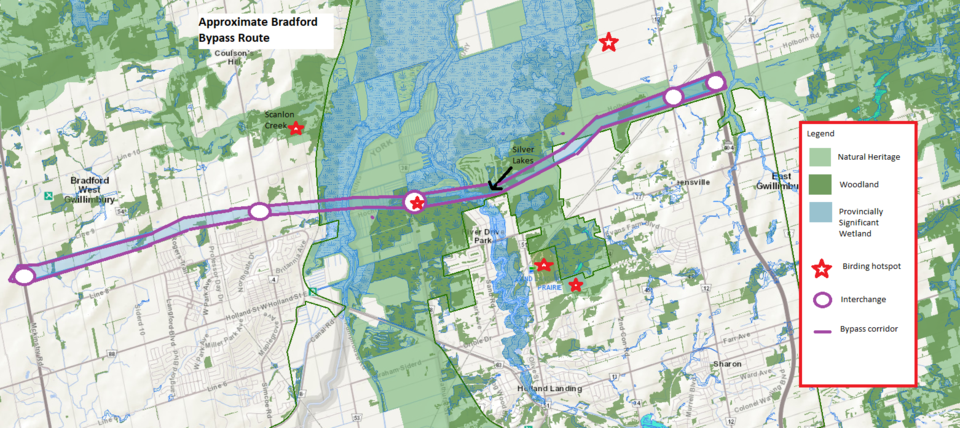NEWS RELEASE
RESCUE LAKE SIMCOE COALITION
*************************
Today, Environmental Defence, Rescue Lake Simcoe Coalition and Simcoe County Greenbelt Coalition asked the federal government to conduct environment assessments (EAs) for two proposed 400-series Ontario highways in environmentally sensitive areas: Highway 413 (GTA West Highway) and the Holland Marsh Highway (Bradford Bypass).
The significant impact on endangered species, migratory birds and aquatic life that will be caused by these highways, along with their associated increase in carbon emissions and the strong local opposition to these projects all meet the conditions for federal EAs.
Ecojustice is representing the groups in their requests to the federal government.
Highway 413 is a proposed mega-highway west of Toronto that was cancelled by the previous Ontario government, but revived by the current one. This unneeded highway will cause irreversible environmental damage within federal jurisdiction, including harm to fish habitat, multiple federal species at risk, and dozens of significant wetlands, forests, and important ecosystems.
The Province’s proposal to weaken its EA process for this highway would prevent proper study and mitigation measures for these impacts prior to construction, as well as exclude any consideration of the climate change impacts of the project.
Highway 413 has already met the criteria for public concern to justify a federal EA. Thousands of Ontarians have written to the Province asking them to reconsider this dangerous and unnecessary proposal. This strong public opposition has received significant media coverage. For these reasons and many others, Environmental Defence is calling on the federal government to designate Highway 413 for a federal environmental assessment.
"Ontario's slapdash approach to building Highway 413 could mean severe damage to our environment, including wetlands, forests, farmlands, water sources, endangered species, and people’s homes," said Sarah Buchanan, Ontario Climate Program Manager at Environmental Defence. "It would also put more cars and trucks on the road, at a time when the federal government has pledged to cut carbon emissions from transportation. But without a proper environmental assessment, we won’t know these impacts until it’s too late. If the province won't protect our environment, the federal government needs to step in now."
The Holland Marsh Highway is a proposed fully separated highway located in Simcoe County and York Region near Lake Simcoe. The highway will cross through what is now the Holland Marsh, one of the most productive specialty crop agricultural areas in the country, Greenbelt areas and one of the most important wetlands in Southern Ontario. It is estimated that the development of this project will lead to the removal of approximately 39 hectares of wildlife habitat and large areas of important wetlands. The project would cause significant groundwater contamination and would put Lake Simcoe and the Greenbelt at risk.
"There aren't sufficient studies to demonstrate that this new highway would improve traffic conditions and most traffic experts agree that new highways don't reduce congestion in the long-term. If the Holland Marsh Highway is built, Bradford would become a place people drive through, without stopping. That would impact their downtown, small businesses and community health. We're putting a lot at risk and spending a lot of money so Bradford can become a drive-through community," said Margaret Prophet, Executive Director, Simcoe County Greenbelt Coalition.
In the mid-2000s, the Holland Marsh Highway was shelved as being incompatible with growth planning under the Provincial Places to Grow Act. Twenty-three years later, Premier Ford’s government resurrected the project, proposing to exempt the Holland Marsh Highway from completion of EA updates prior to construction. The province’s approach would not require the Ministry of Transportation to complete proper studies on potentially harmful effects such as noise and groundwater contamination.
Rescue Lake Simcoe Coalition and Simcoe County Greenbelt Coalition say that the original 1997 EA for the Holland Marsh Highway was irresponsible, failing to consider cumulative effects, climate change, or detail the impacts on natural heritage, migratory birds, fisheries, First Nations cultural heritage and air pollution. The groups are calling on the federal government to request a comprehensive EA to address these and many other impacts to human and environmental health that have been overlooked in the previous EA.
“Lake Simcoe is stressed by development impacts, salt from the expanding road network, and excess nutrients already. Historically, the Holland Marsh filtered pollutants from the waters that flowed into the lake. It is extremely sensitive, and a wholly inappropriate place to put a highway,” said the Rescue Lake Simcoe Coalition’s Executive Director, Claire Malcolmson.
“The Ontario government has repeatedly demonstrated disregard for environmental protections in Ontario in favour of development projects. Now they are trying to do it again by pushing through two highway proposals that will lead to significant, irreversible impacts on important habitats, wildlife, and watersheds in the province,” said Laura Bowman, Ecojustice lawyer. “Our clients are urging Minister Wilkinson to stand up for Ontarians and require Highway 413 and the Holland Marsh Highway to undergo federal environmental assessments that look at all the possible impacts these projects will have on the federal aspects of the environment, communities, and the climate, before they can move ahead.”
*************************



